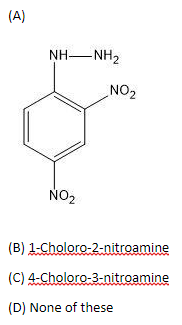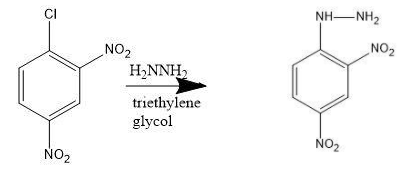
What will be the final product of the reaction?




Answer
565.8k+ views
Hint: A good nucleophile can stabilize the reaction and also it makes it easy to replace the existing substitute. Here, the nucleophile is hydrazine so the product will have the substitute which would be related to the hydrazine molecule.
Complete step by step solution:
Let us discuss the process of nucleophilic addition of hydrazine: The given reaction is of 2, 4 dinitrochlorobenzene reacting with hydrazine. The presence of two nitro groups which are electron accepting groups, makes it easy for chloride to get displaced. Chlorine is the ortho, para directing group. So, nitration of chlorine is feasible for stable products. Chlorobenzene is prepared from benzene (here the reactant).
Procedure-
-2, 4 dinitrochlorobenzene is dissolved in triethylene glycol. The hydrazine solution is added to it.
-The mixture is then refluxed by stirring it for an hour nearly.
-The product starts forming in the prior ten minutes only.
-It is then cooled and again alcohol is added to remove unchanged halide.
Illustration-
-The reaction of 2, 4 dinitrochlorobenzene with hydrazine in the presence of triethylene glycol gives nucleophilic substitution reaction. This forms the stable product as 2, 4 dinitrophenylhydrazine.
-Reaction takes place as follows;

Therefore, option (A) is correct.
Additional information:
The aqueous solution of 2, 4 dinitrophenylhydrazine (DNP) is known as Brady’s reagent which reacts with carbonyl compounds to give coloured precipitates who have a sharp melting point.
DNP has the risk of explosion, so it's transported wet.
Note: The good nucleophile eases the reaction and hence replacement of chloride is feasible when hydrazine takes the position. If any of the options have hydrazine substitute, then you can ignore option (D) from the very beginning of the solution.
Complete step by step solution:
Let us discuss the process of nucleophilic addition of hydrazine: The given reaction is of 2, 4 dinitrochlorobenzene reacting with hydrazine. The presence of two nitro groups which are electron accepting groups, makes it easy for chloride to get displaced. Chlorine is the ortho, para directing group. So, nitration of chlorine is feasible for stable products. Chlorobenzene is prepared from benzene (here the reactant).
Procedure-
-2, 4 dinitrochlorobenzene is dissolved in triethylene glycol. The hydrazine solution is added to it.
-The mixture is then refluxed by stirring it for an hour nearly.
-The product starts forming in the prior ten minutes only.
-It is then cooled and again alcohol is added to remove unchanged halide.
Illustration-
-The reaction of 2, 4 dinitrochlorobenzene with hydrazine in the presence of triethylene glycol gives nucleophilic substitution reaction. This forms the stable product as 2, 4 dinitrophenylhydrazine.
-Reaction takes place as follows;

Therefore, option (A) is correct.
Additional information:
The aqueous solution of 2, 4 dinitrophenylhydrazine (DNP) is known as Brady’s reagent which reacts with carbonyl compounds to give coloured precipitates who have a sharp melting point.
DNP has the risk of explosion, so it's transported wet.
Note: The good nucleophile eases the reaction and hence replacement of chloride is feasible when hydrazine takes the position. If any of the options have hydrazine substitute, then you can ignore option (D) from the very beginning of the solution.
Recently Updated Pages
Master Class 12 Business Studies: Engaging Questions & Answers for Success

Master Class 12 Economics: Engaging Questions & Answers for Success

Master Class 12 English: Engaging Questions & Answers for Success

Master Class 12 Maths: Engaging Questions & Answers for Success

Master Class 12 Social Science: Engaging Questions & Answers for Success

Master Class 12 Chemistry: Engaging Questions & Answers for Success

Trending doubts
What are the major means of transport Explain each class 12 social science CBSE

Which are the Top 10 Largest Countries of the World?

Draw a labelled sketch of the human eye class 12 physics CBSE

Explain sex determination in humans with line diag class 12 biology CBSE

The pH of the pancreatic juice is A 64 B 86 C 120 D class 12 biology CBSE

Give 10 examples of unisexual and bisexual flowers




